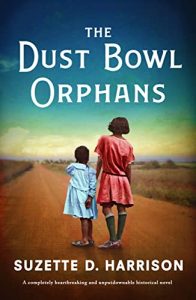HOW TO WRITE YOURSELF CRAZY: Dual Timelines . . . or Split Personalities?
HOW TO WRITE YOURSELF CRAZY:
Dual Timelines . . . or Split Personalities?
By Suzette D. Harrison, author of
The Dust Bowl Orphans
 Listen! I love writing. It’s one of my divine purposes and passions. Writing is the one thing I’d do even if I wasn’t paid to. Let’s be clear: I want to be paid in a big, big way. Like in a quit my day job and do this for the rest of my life kind of situation. To that end, I’m burning candles, praying, chanting, cleansing my aura; raising my energy, setting intentions and a host of other faith-and-spirit things. I’d even sleep outside in the rain after singing spirituals and eating cold chittlins if that would guarantee my full-time writing dream. I think. But, wait, I digress. Let’s get back to my love of this creative writing discipline.
Listen! I love writing. It’s one of my divine purposes and passions. Writing is the one thing I’d do even if I wasn’t paid to. Let’s be clear: I want to be paid in a big, big way. Like in a quit my day job and do this for the rest of my life kind of situation. To that end, I’m burning candles, praying, chanting, cleansing my aura; raising my energy, setting intentions and a host of other faith-and-spirit things. I’d even sleep outside in the rain after singing spirituals and eating cold chittlins if that would guarantee my full-time writing dream. I think. But, wait, I digress. Let’s get back to my love of this creative writing discipline.
Since returning to the literary scene in 2016, I’ve had wonderful, creative opportunities. I’ve written in two different series, Decades: A Journey of African-American Romance and the Distinguished Gentlemen, respectively. I’ve made dynamic connections, sisterhoods, and networked with other authors (which is challenging for me, an introvert); coached other aspiring writers waiting in the wings. I’ve self-published, been published traditionally. The journey has been rewarding. What I didn’t anticipate in this great author adventure was writing a dual timeline, multigenerational story. I’m talking two heroines, two different time periods. That’s double the plot, the tension, the climax; twice the love, pain, joy, and resolution. Yet, it’s what I did, and am doing.
Have you met Mattie? Or Ashlee? They’re the heroines from my award-winning 2021 release, The Girl at the Back of the Bus. Mattie hails from 1955, and Ashlee contemporary times. The novel requires readers to move back and forth between two protagonists, almost like a cerebral tennis match. Even numbered chapters belong to Mattie; odd to Ashlee. Their stories are uniquely their own, like trains traveling parallel tracks, only for readers to discover that Mattie and Ashlee are intimately connected. As the conductor of this train, writing a two-in-one story dynamic was complex. Challenging. But as an author I look for ways to grow and improve my craft. The Girl at the Back of the Bus stretched me immensely. As a lover of African-American history, I immediately connected with Mattie and found myself having to circle back and give equal love to Ashlee. It was an act of ultimate multitasking. Exhilarating, often exhausting. Would I dare to do it again? I already have in The Dust Bowl Orphans.
Meet Faith Wilson and Zoe Edwards, the heroines of my latest dual timeline offering releasing this February. Again, they’re two women decades and generations apart who are divinely connected. Picture it. Wellston, Oklahoma 1935: Faith is fifteen and—courtesy of the most horrific dust storm in U.S. history—is alone with her baby sister, facing a harrowing journey and separation from family. Zoe, on the other hand, is our current day college graduate, art curator, and a wounded wife who needs to sign divorce papers. On the surface their lives are dissimilar, yet down in the deep where undercurrents exist, their spirits are linked. Separated by time and circumstances, they experience a supernatural reconnection. Intrigued? Good! The novel releases February 7th and will be available in paperback, eBook, and on Audible. But now a few tidbits for my fellow wordsmiths who’ve been tossing around questions of “should I, should I not, jump into this dual timeline pot?”
Listen, if you have two characters from different worlds or times simultaneously vying for your attention, and they somehow have definite connections, why not? Don’t tell yourself you can’t possibly fit them together. Think again. You’re an author, you pen into existence previously nonexistent people and places. You’re a world-knitter. Allow me to offer a few hints for fellow wordsmiths wild enough to consider writing a dual narrative:
- Keep your stories organized, straight. Nothing anachronistic like putting an iPad in the hands of your historical heroine (or hero), unless time travel is at play.
- End each chapter with a cliffhanger so that your readers race through the next to circle back to the chapter and character they just left.
- Show much love to both of your plots and protagonists, the historical and the current day. Even if you favor one above the other. (Kind of how I was initially, instantly smitten by Mattie and neglected Ashlee. I circled back and gave Ashlee some love, learned from that mistake, and came out the gate giving much time and attention to both Faith and Zoe).
- Be patient with yourself. This multi-story business is almost like using both sides of your brain. Simultaneously. That right there is enough to make somebody, somewhere just a touch of crazy.
- Enjoy the process and make new discoveries. You may find those writing muscles stretching, growing, and even aching. It’s a labor of love, but you’re worth it.
So, brave writing warriors who’ve considered penning dual timeline novels when writing in one era wasn’t enough: buckle up. Brew the coffee. Sip the tea. Enjoy that decade-, character-hopping. No, it’s not the norm, but guess what’s overrated? Normalcy. Wanting to write two varying, distinctively different, interconnected plots in one book isn’t beyond you. And doing so doesn’t make you Sybil. No, it’s not a matter of split personalities. But, okay yes, it requires a teaspoon of crazy, daring, freeing creativity.
THE DUST BOWL ORPHANS
 The dust cloud rolls in from nowhere, stinging our eyes and muddling our senses. I reach for my baby sister and pull her small body close to me. When the sky clears, we are alone on an empty road with no clue which way to go…
The dust cloud rolls in from nowhere, stinging our eyes and muddling our senses. I reach for my baby sister and pull her small body close to me. When the sky clears, we are alone on an empty road with no clue which way to go…
Oklahoma, 1935. Fifteen-year-old Faith Wilson takes her little sister Hope’s hand. In worn-down shoes, they walk through the choking heat of the Dust Bowl towards a new life in California. But when a storm blows in, the girls are separated from their parents. How will they survive in a place where just the color of their skin puts them in terrible danger?
Starving and forced to sleep on the streets, Faith thinks a room in a small boarding house will keep her sister safe. But the glare in the landlady’s eye as Faith leaves in search of their parents has her wondering if she’s made a dangerous mistake. Who is this woman, and what does she want with sweet little Hope? Trapped, will the sisters ever find their way back to their family?
California, present day. Reeling from her divorce and grieving the child she lost, Zoe Edwards feels completely alone in the world. Throwing herself into work cataloguing old photos for an exhibition, she sees an image of a teenage girl who looks exactly like her, and a shiver grips her. Could this girl be a long-lost relation, someone to finally explain the holes in Zoe’s family history? Diving into the secrets in her past, Zoe unravels this young girl’s heartbreaking story of bravery and sacrifice. But will anything prepare her for the truth about who she is…?
A devastating, completely captivating story of family torn apart, fighting to be reunited. Fans of Orphan Train, Before We Were Yours and Where the Crawdads Sing will never forget this powerful story of survival.
BUY HERE
Category: How To and Tips






























